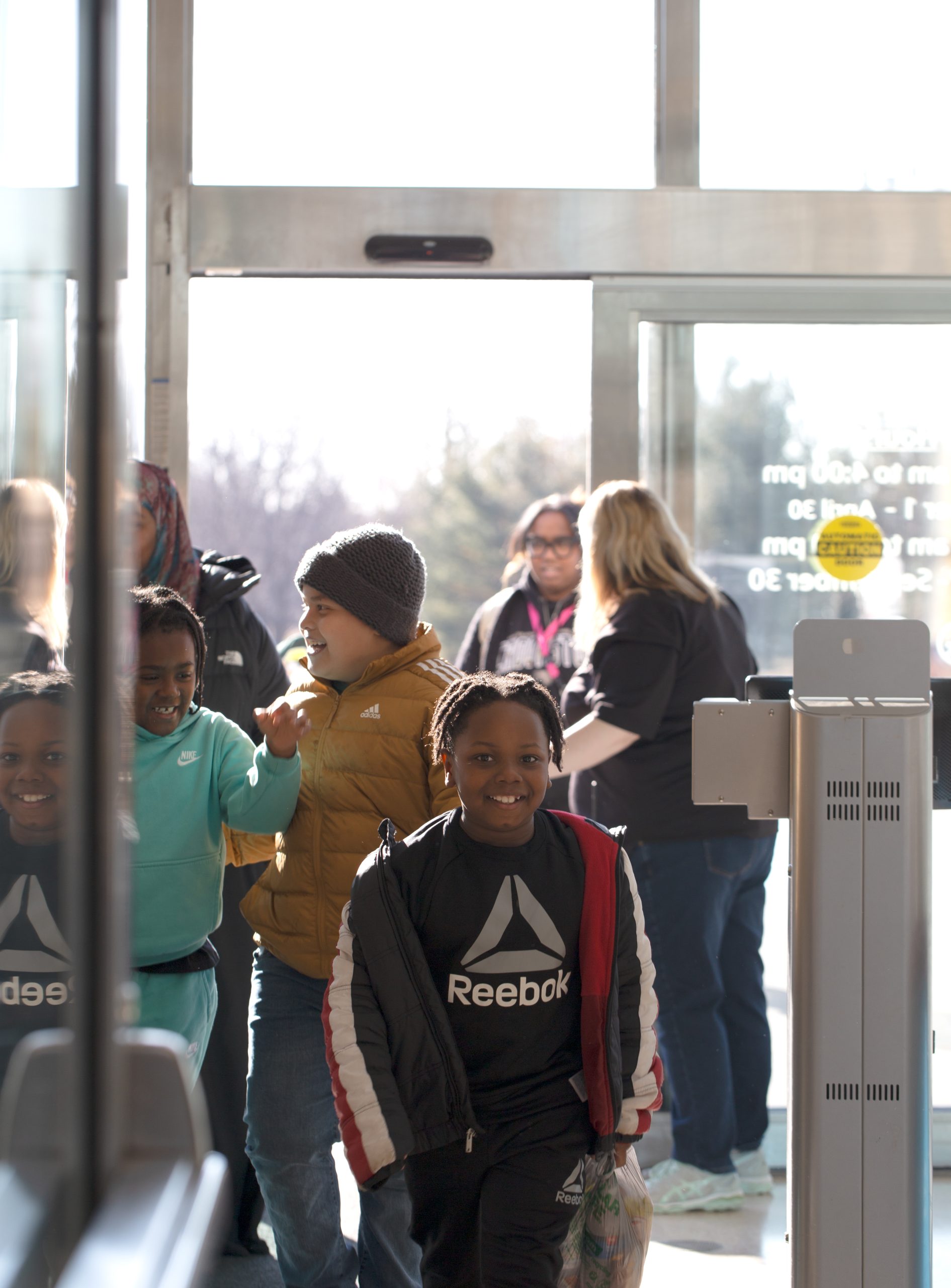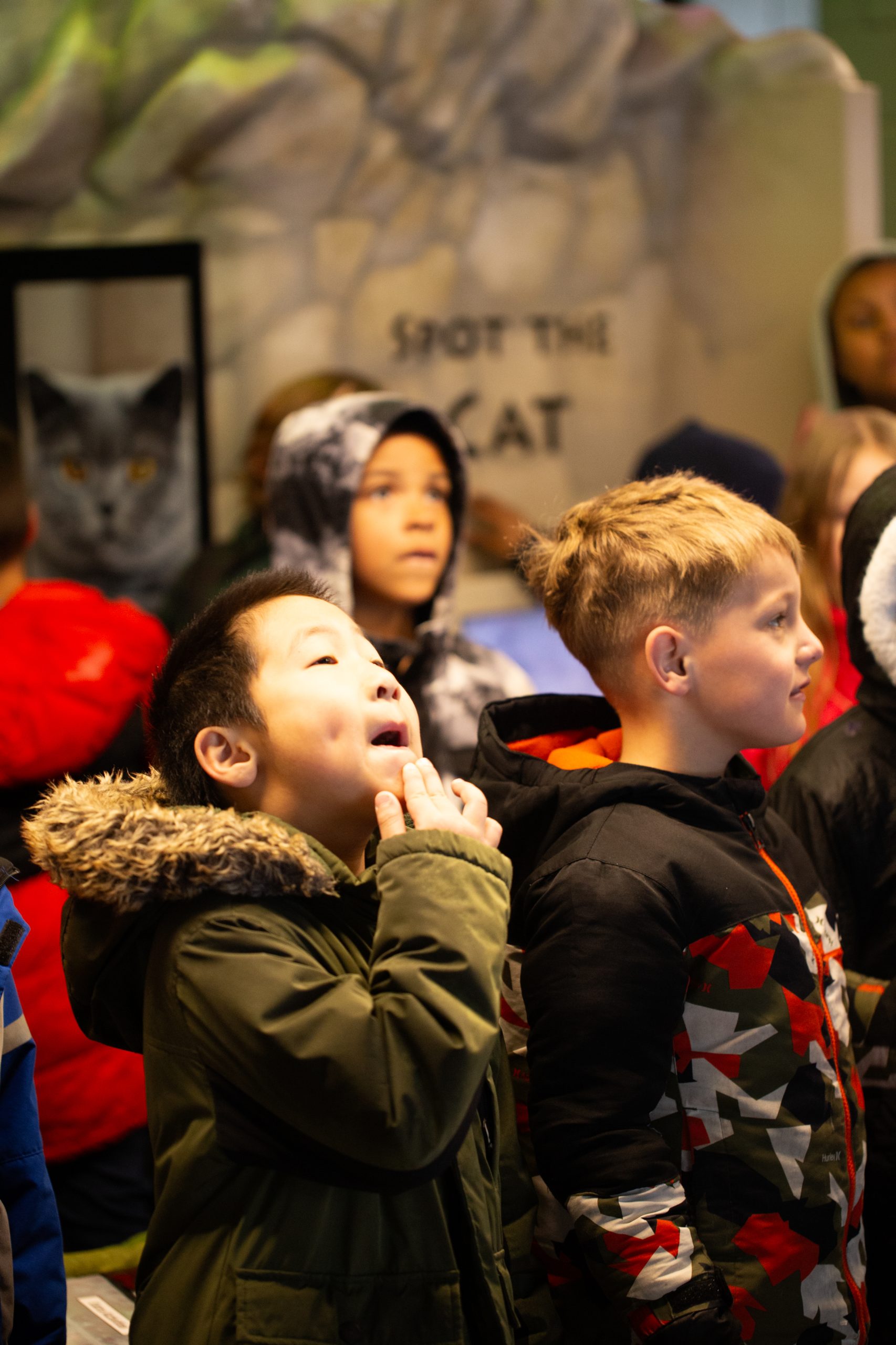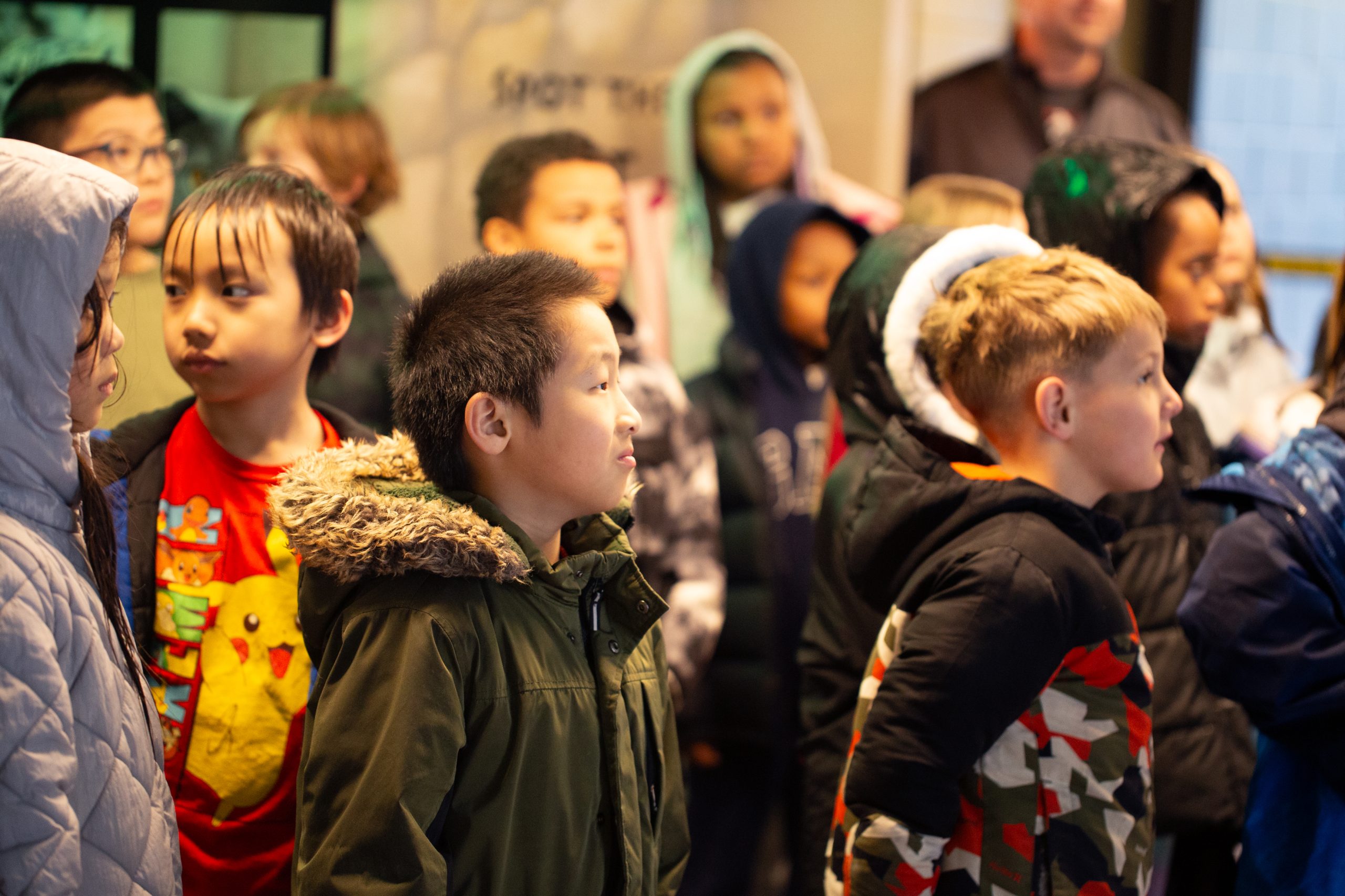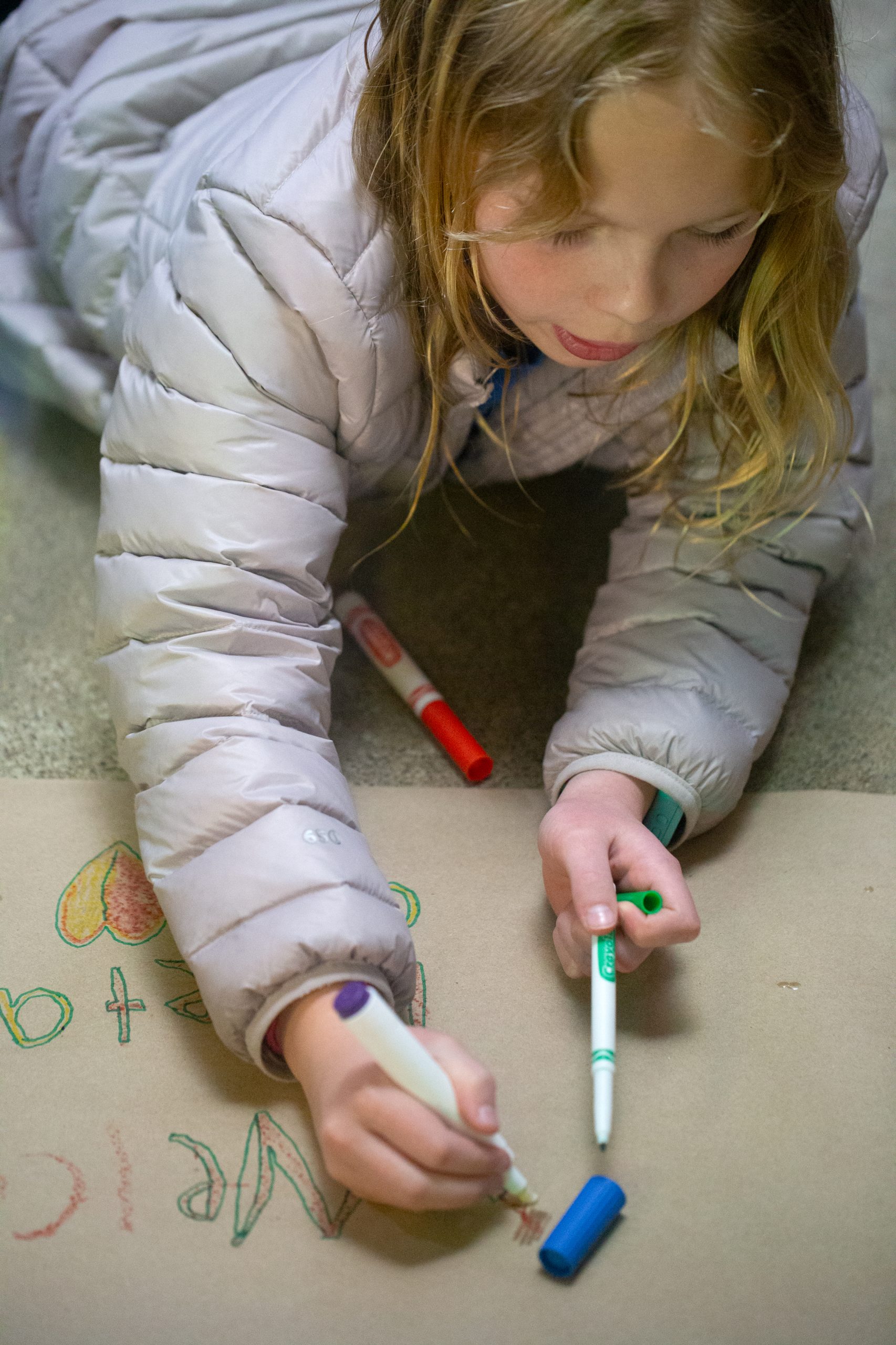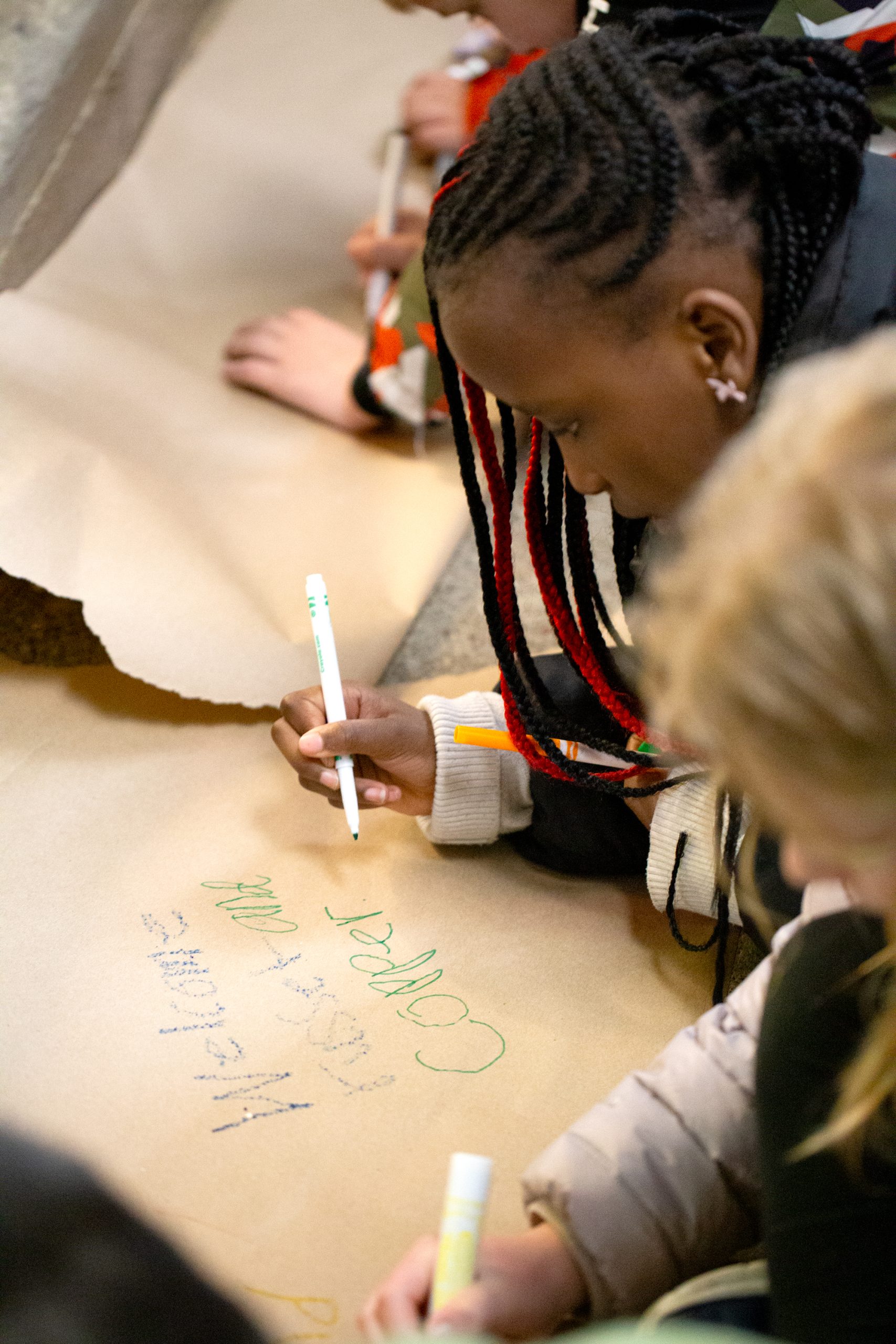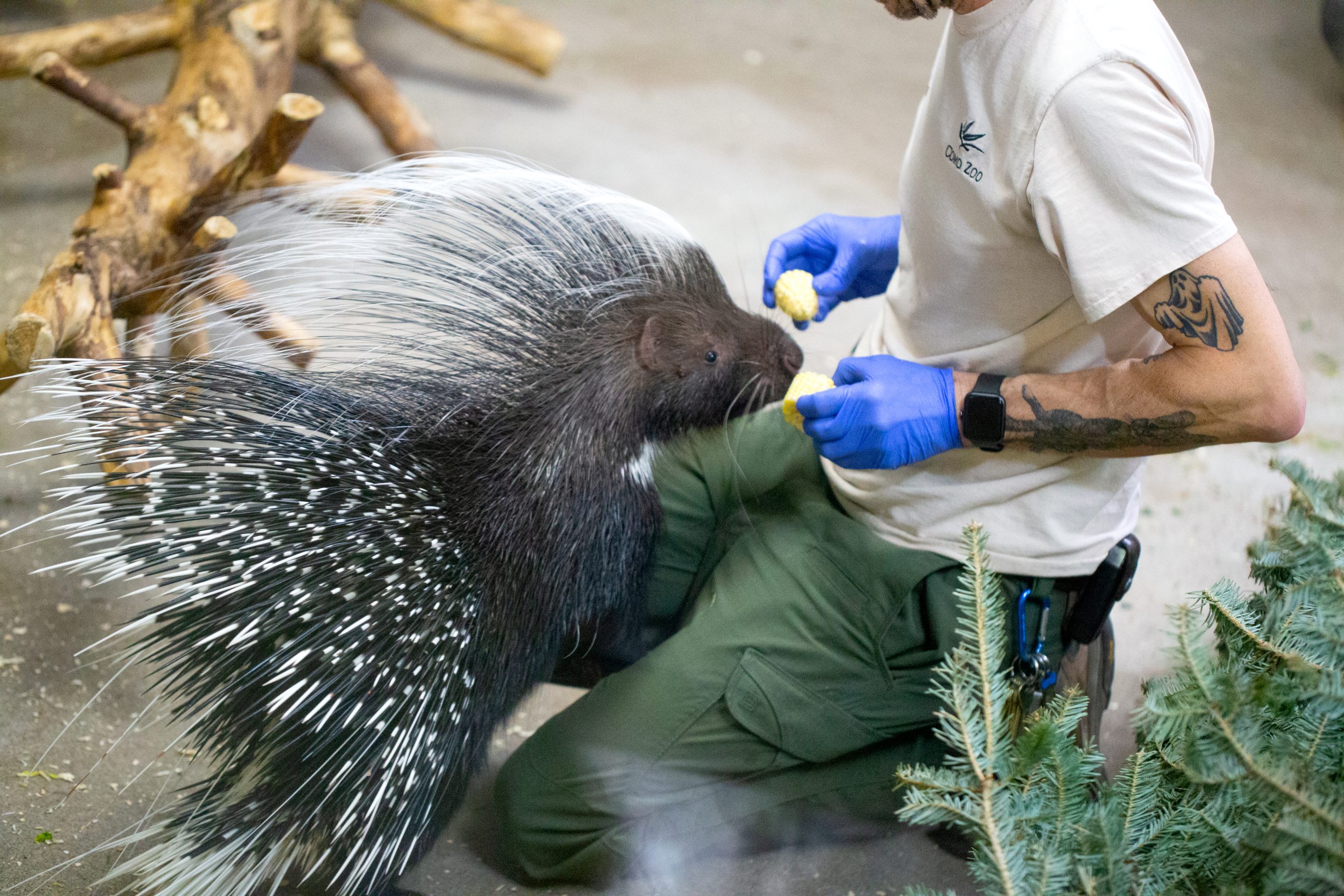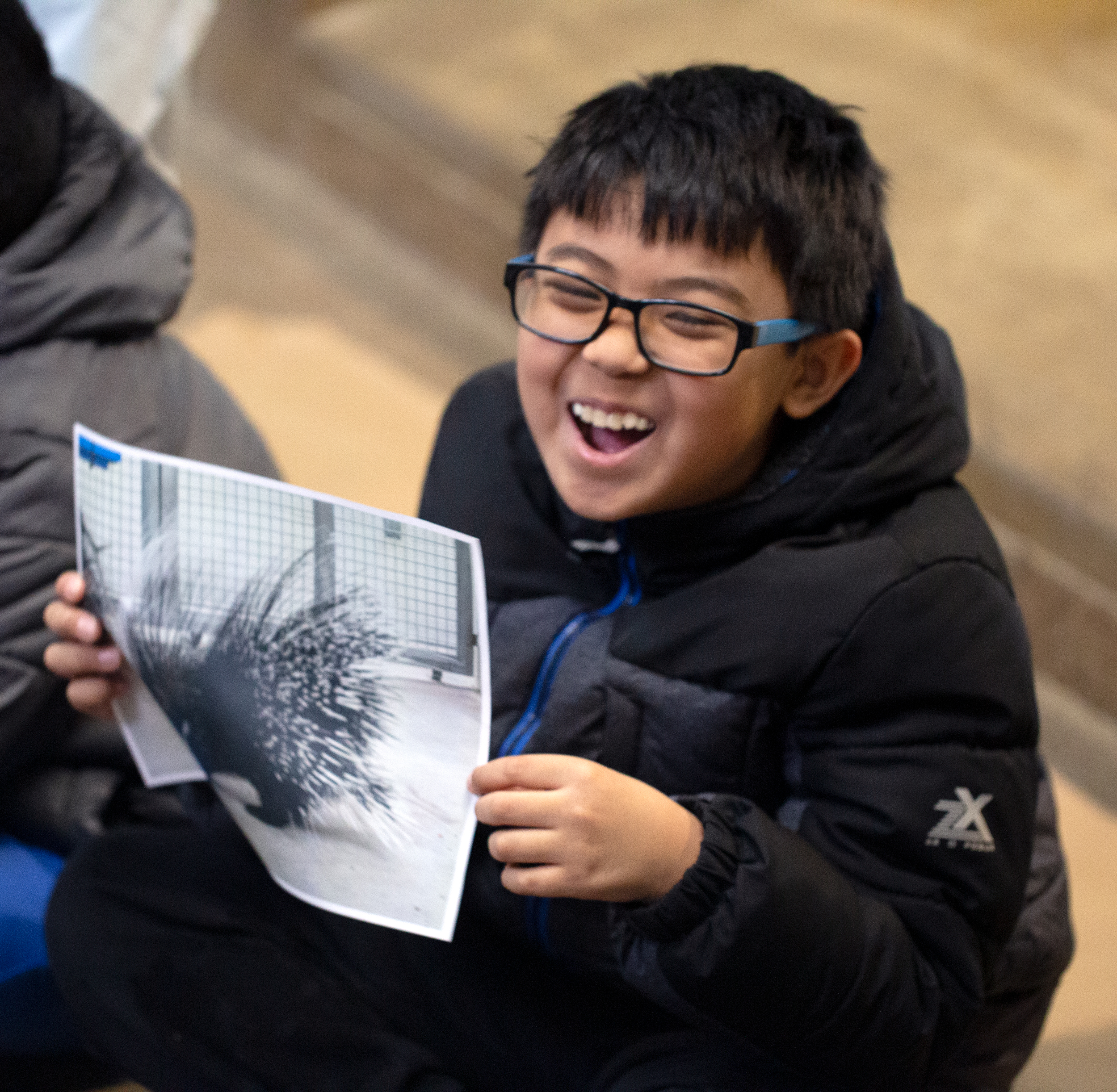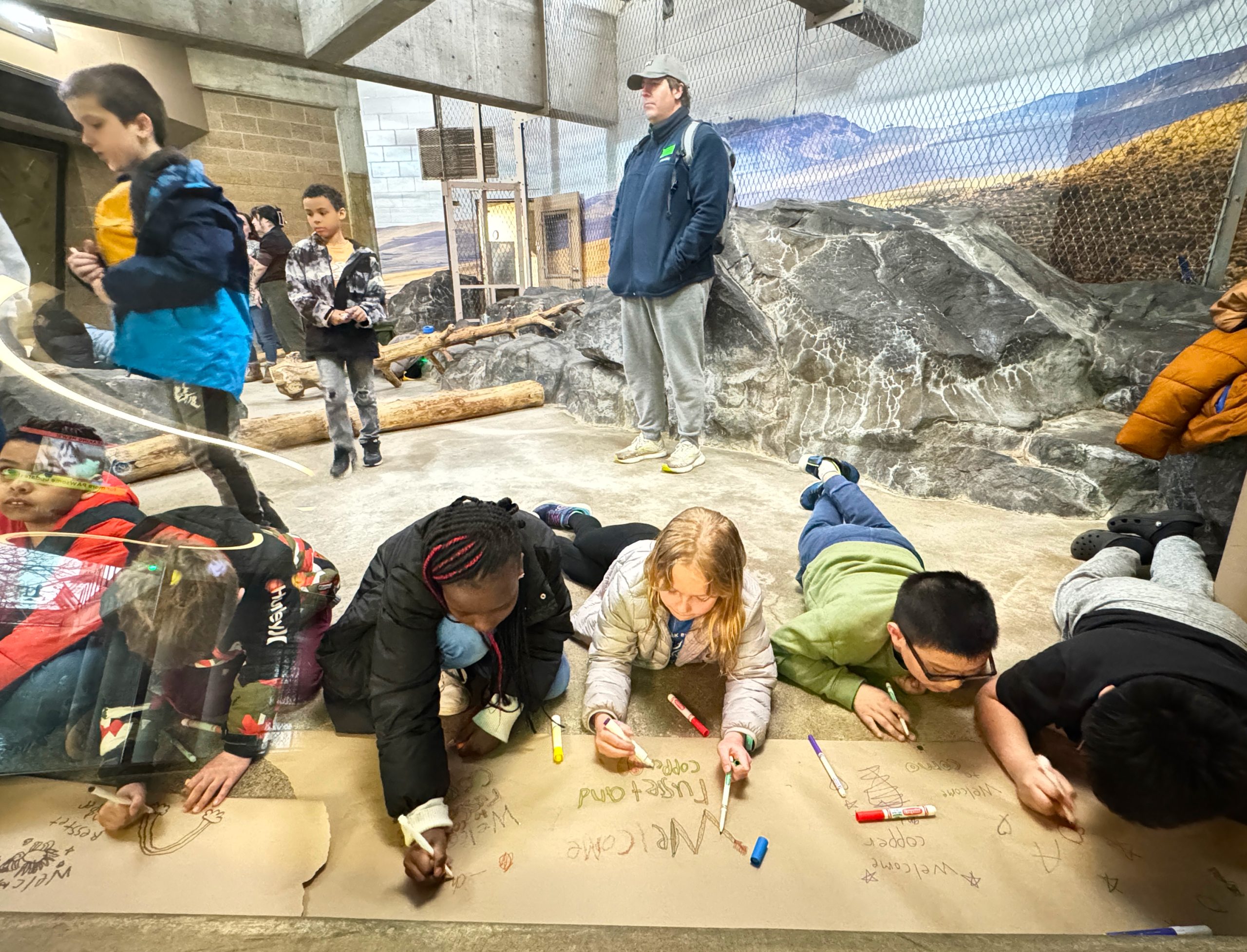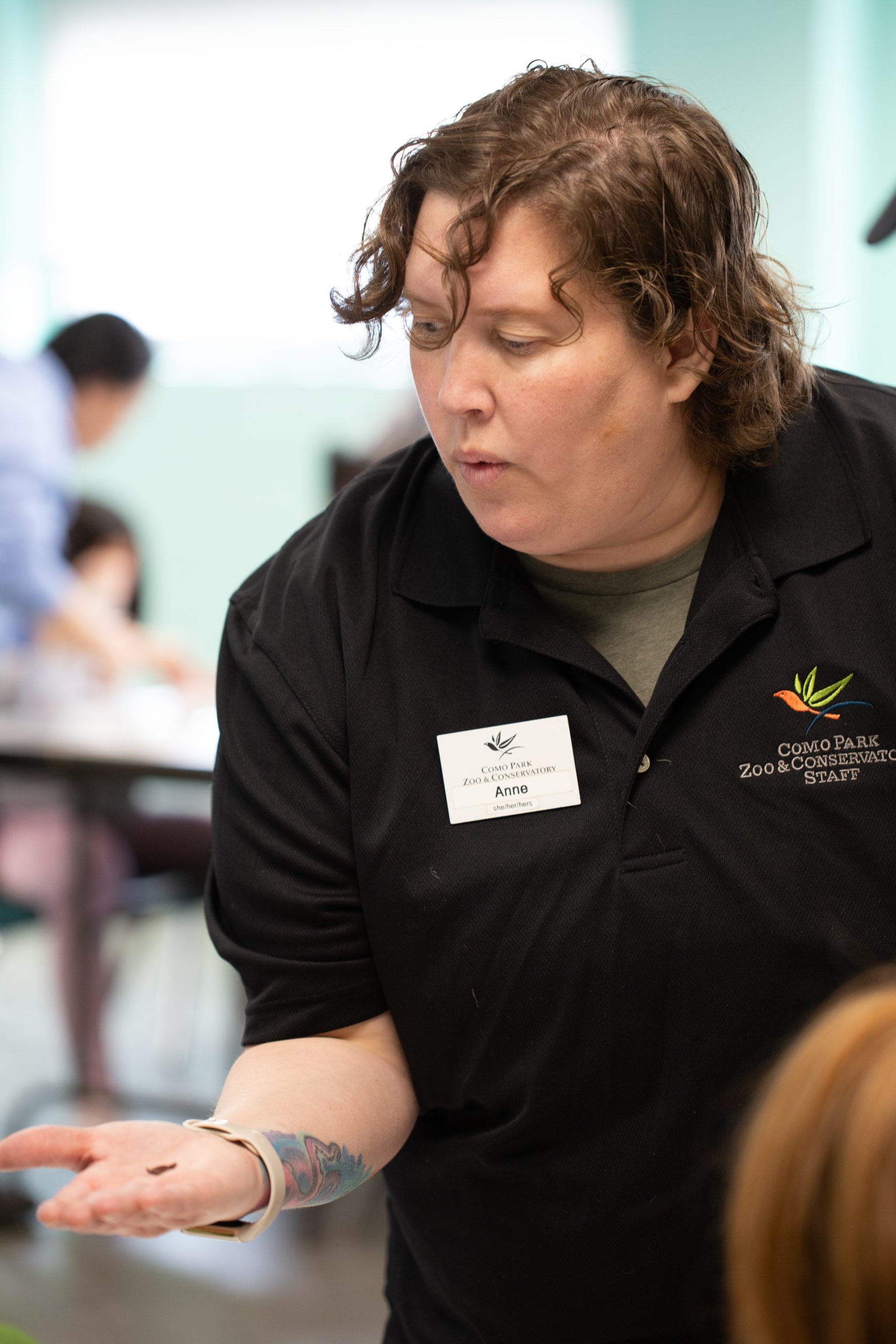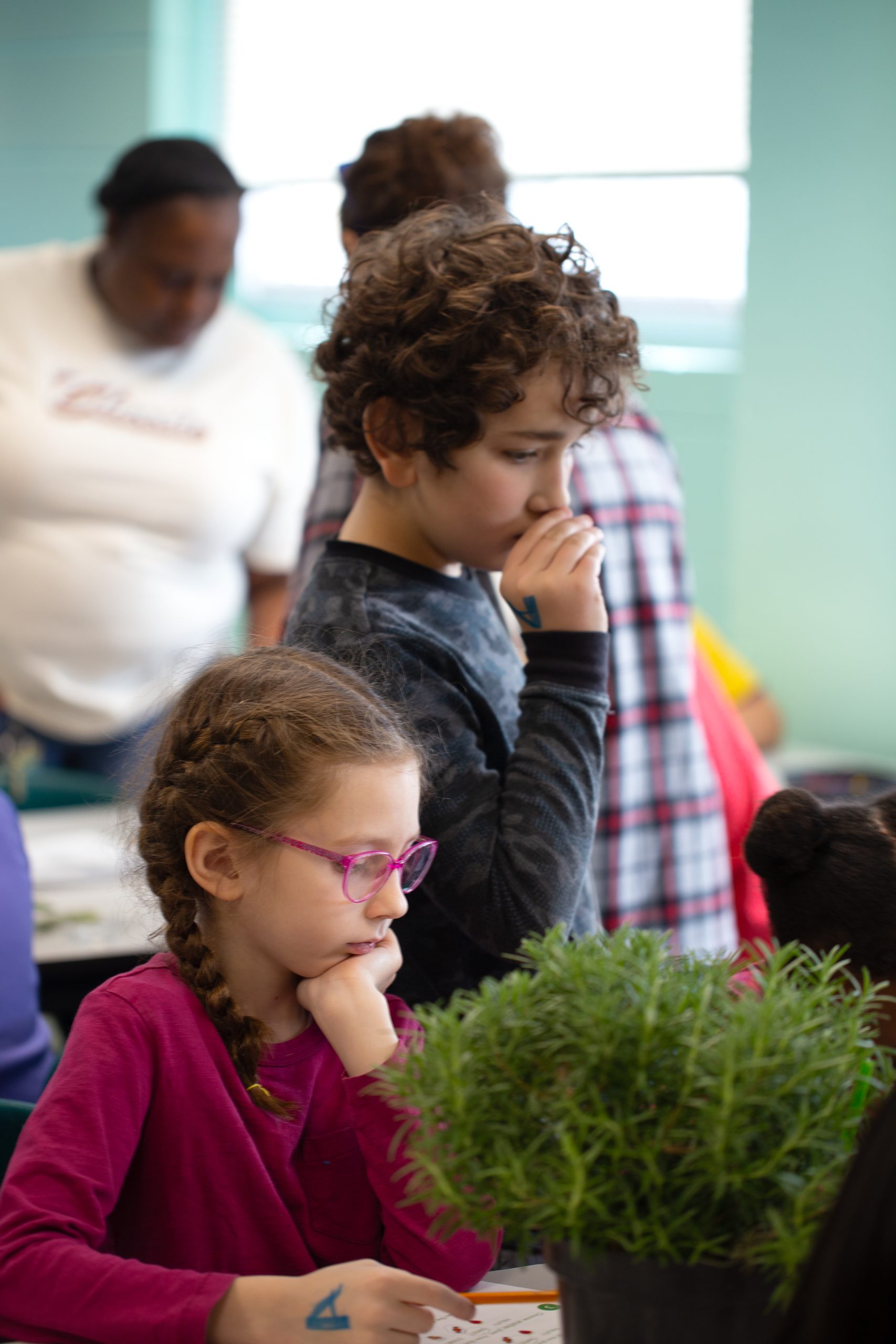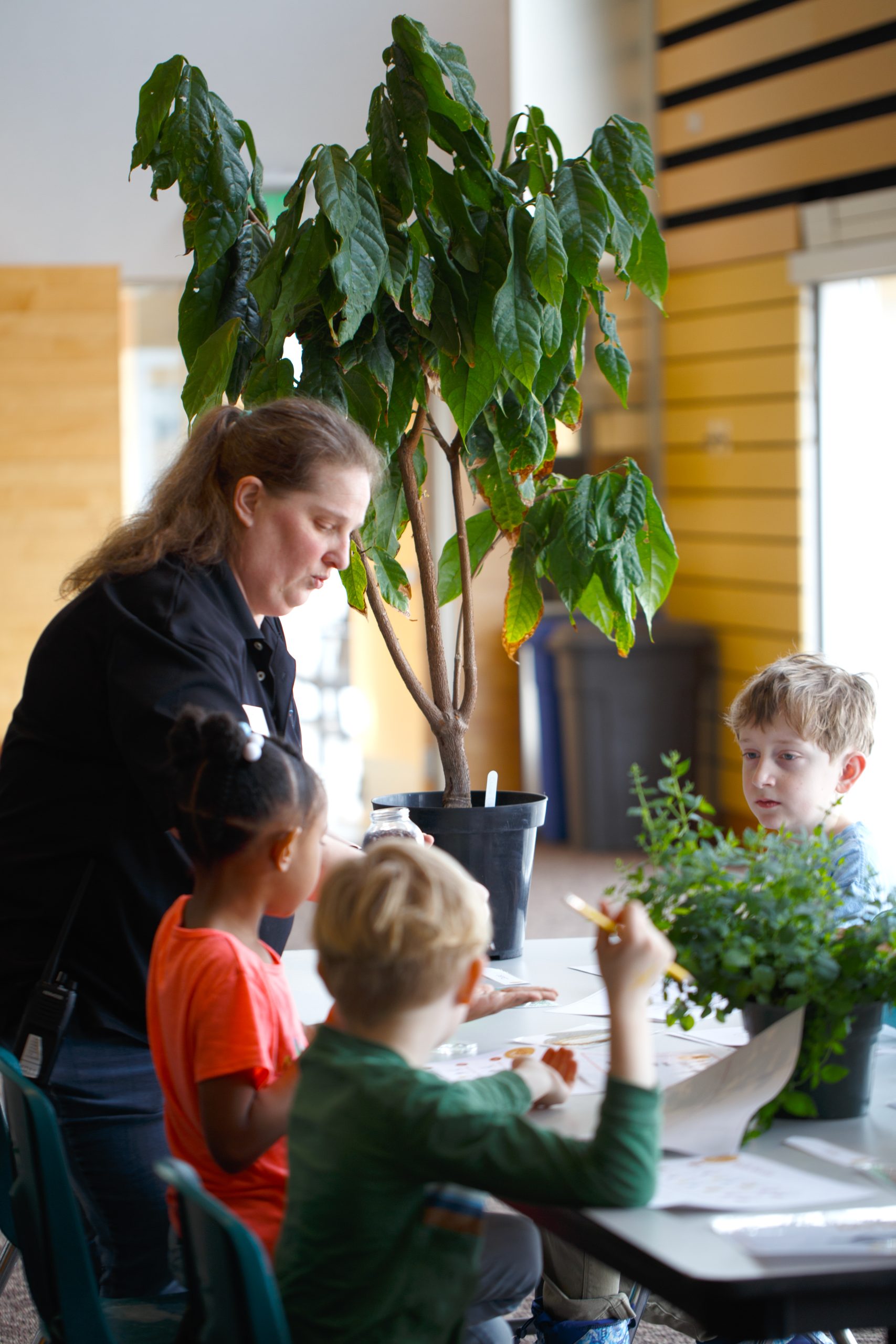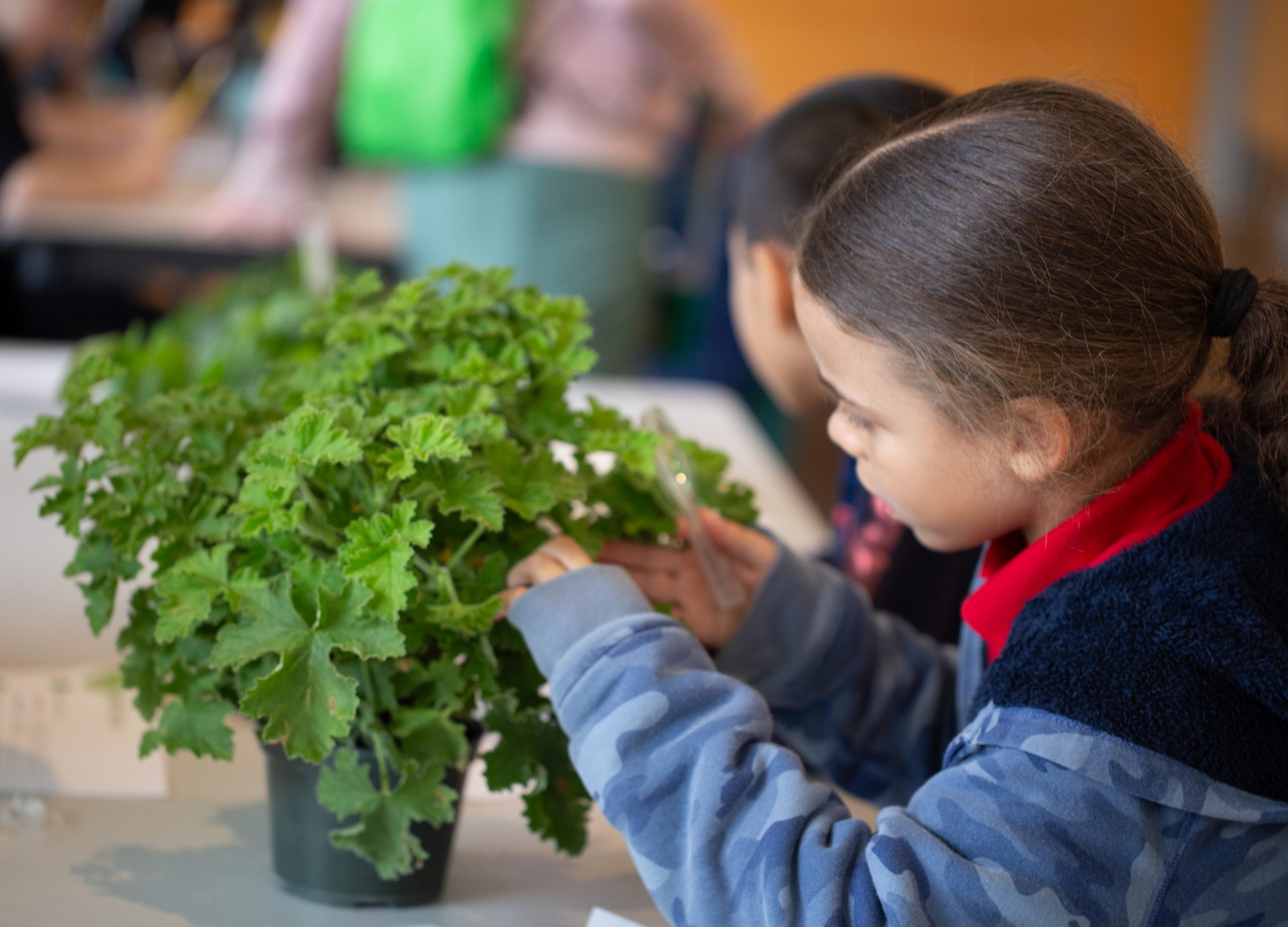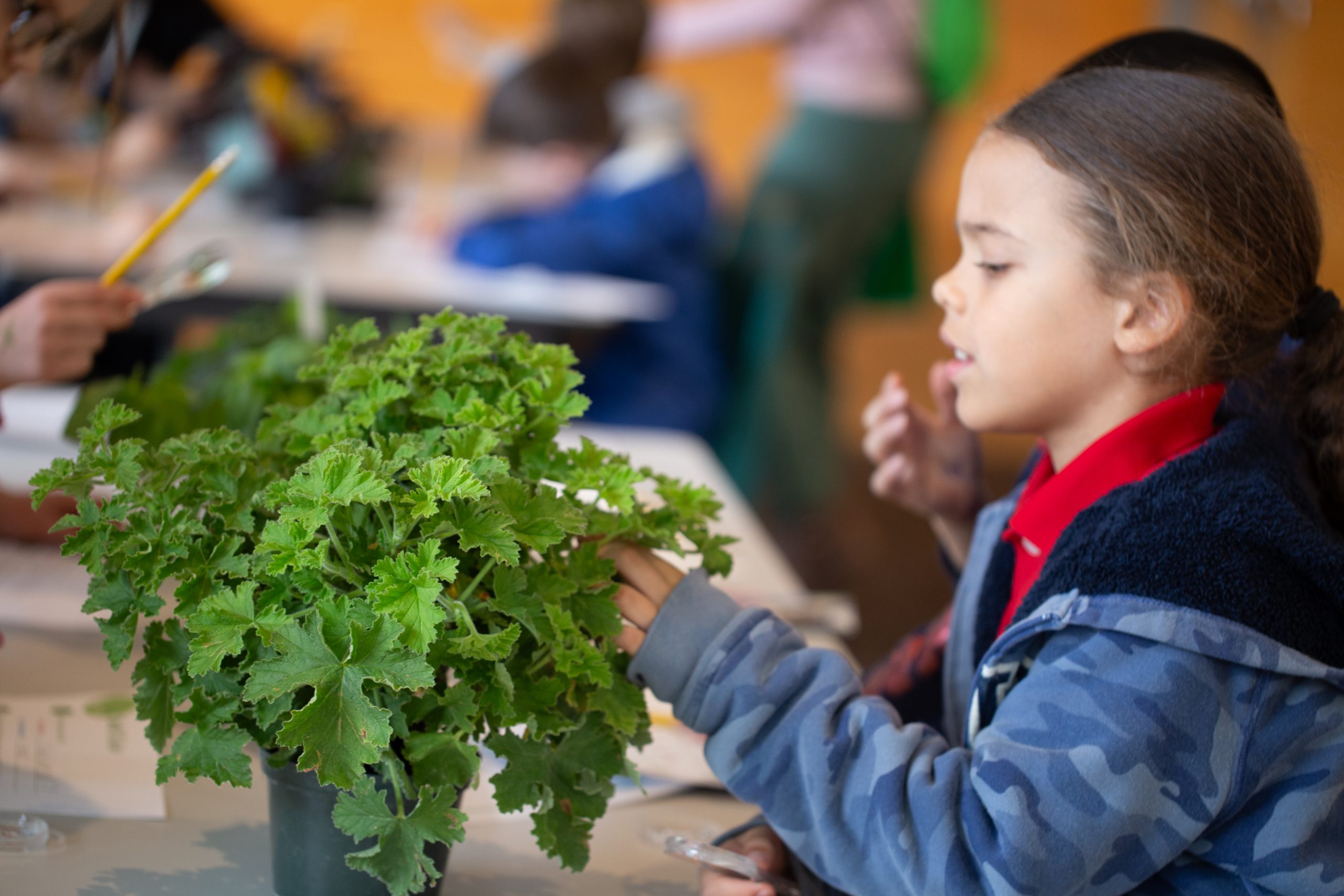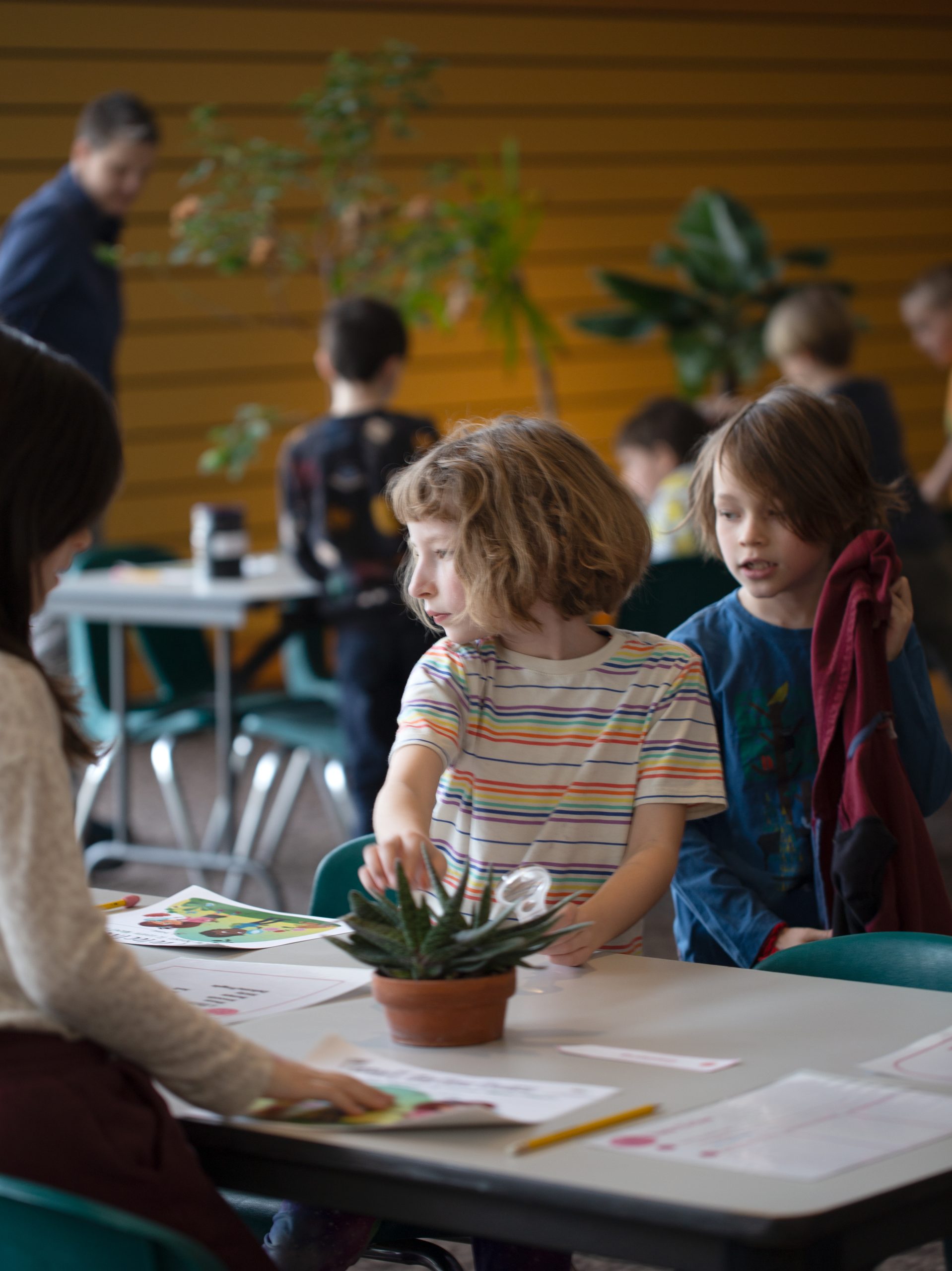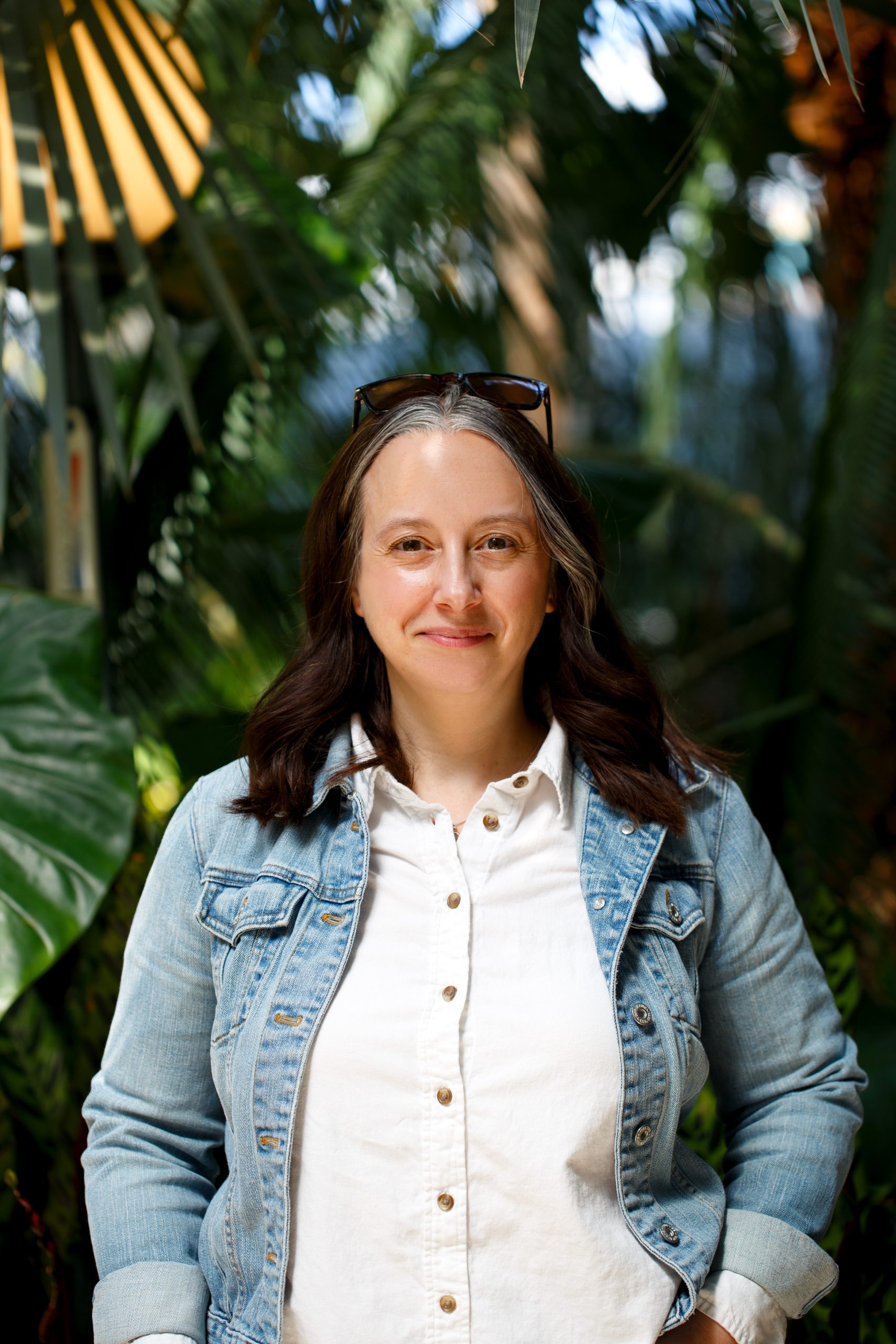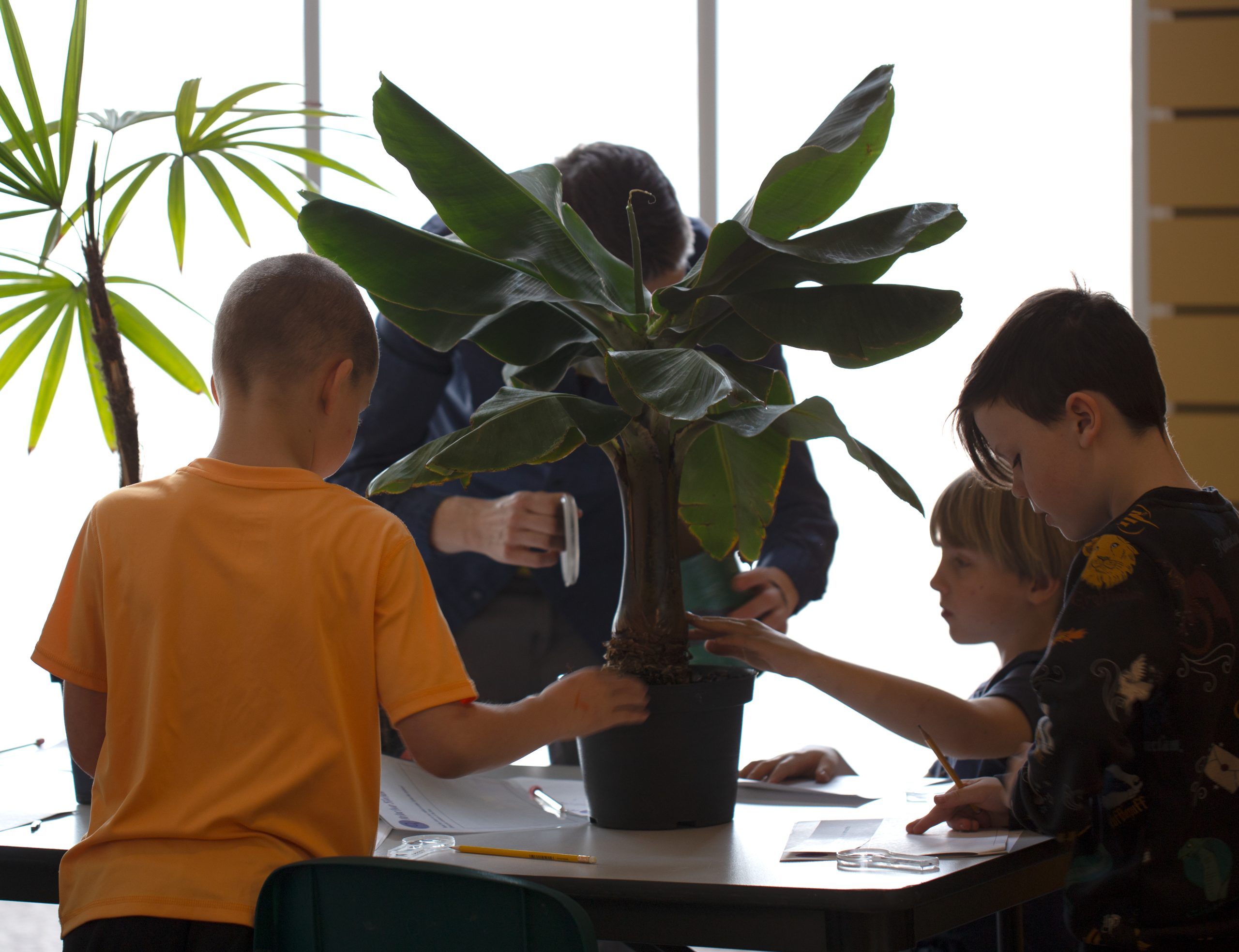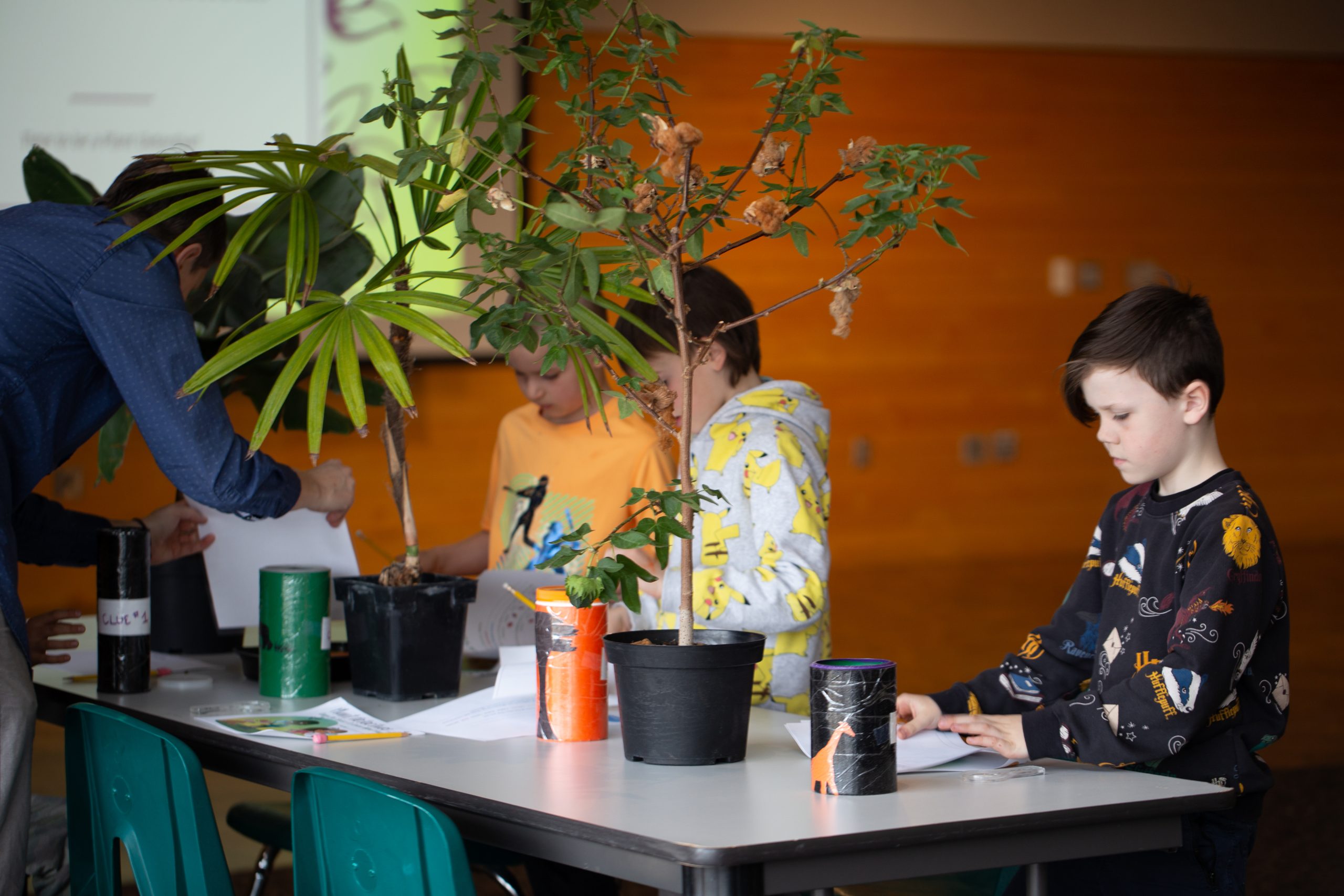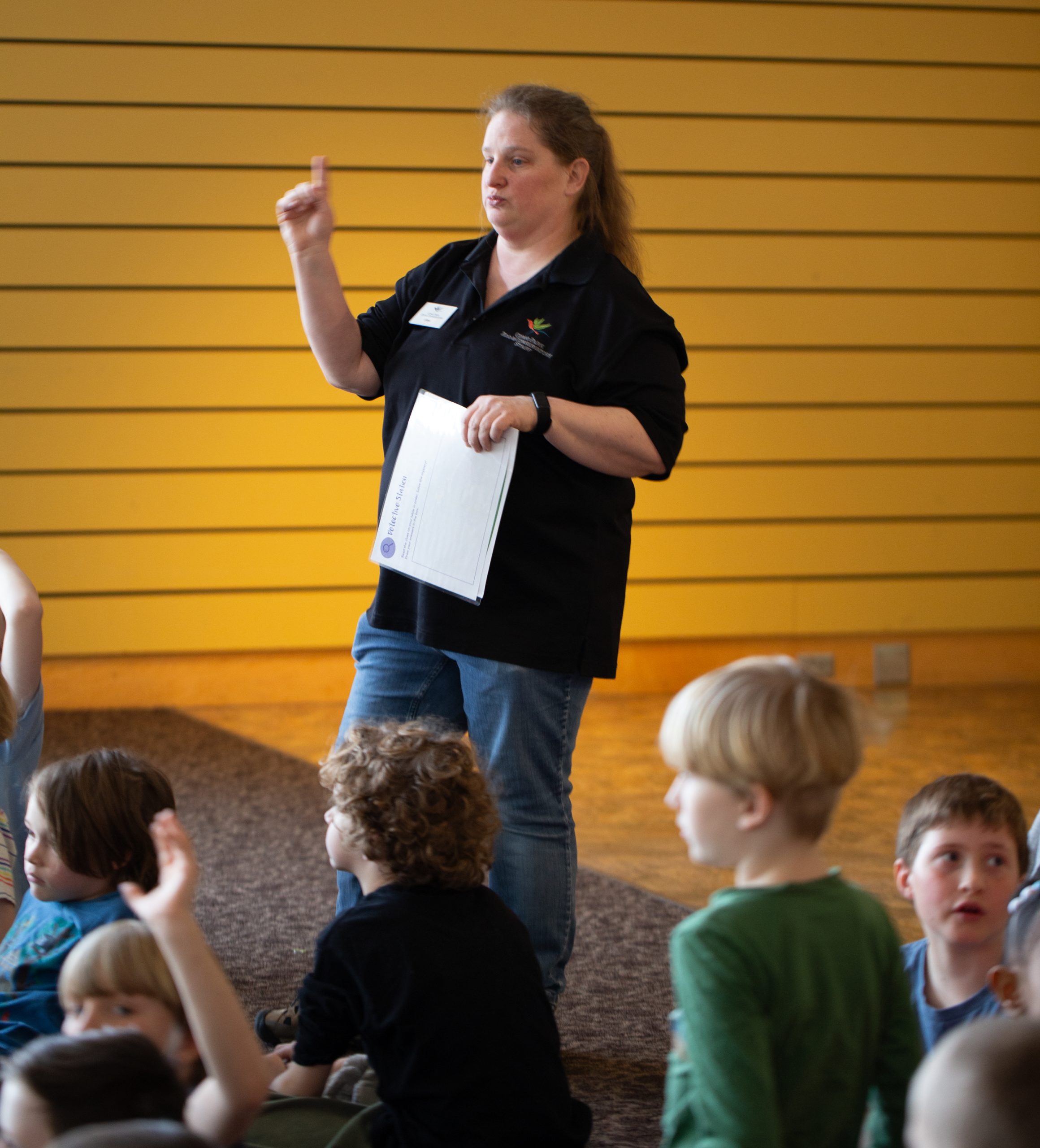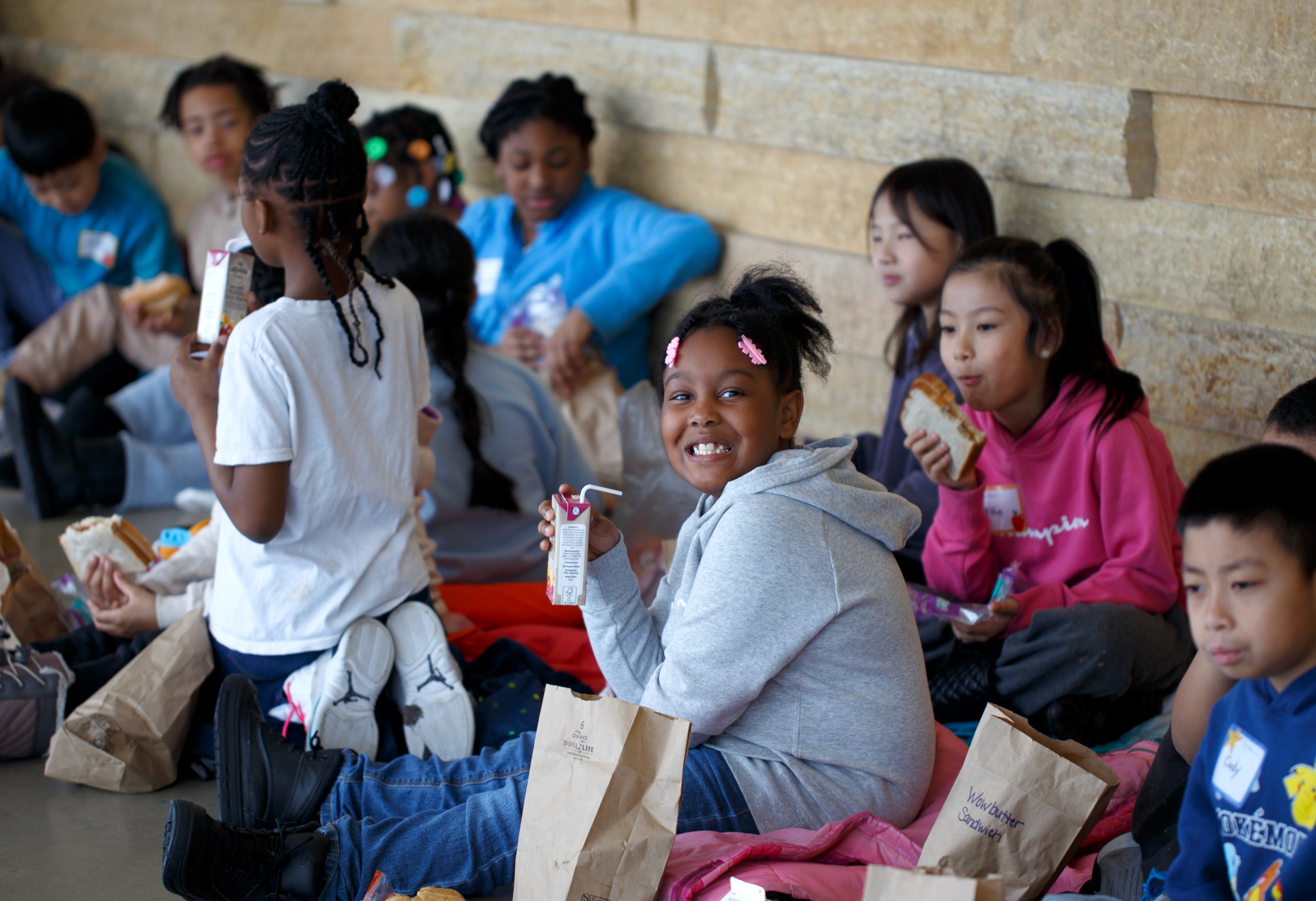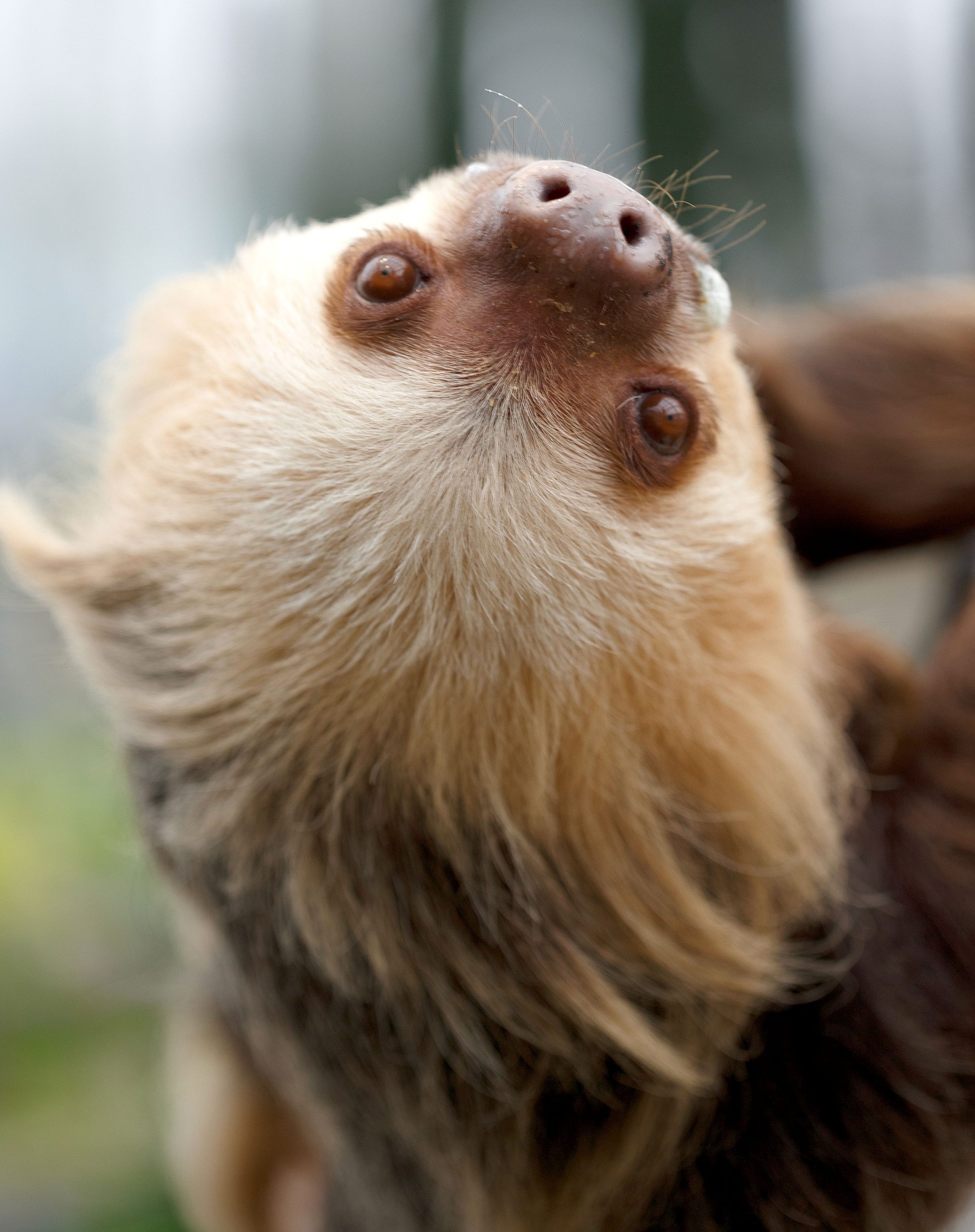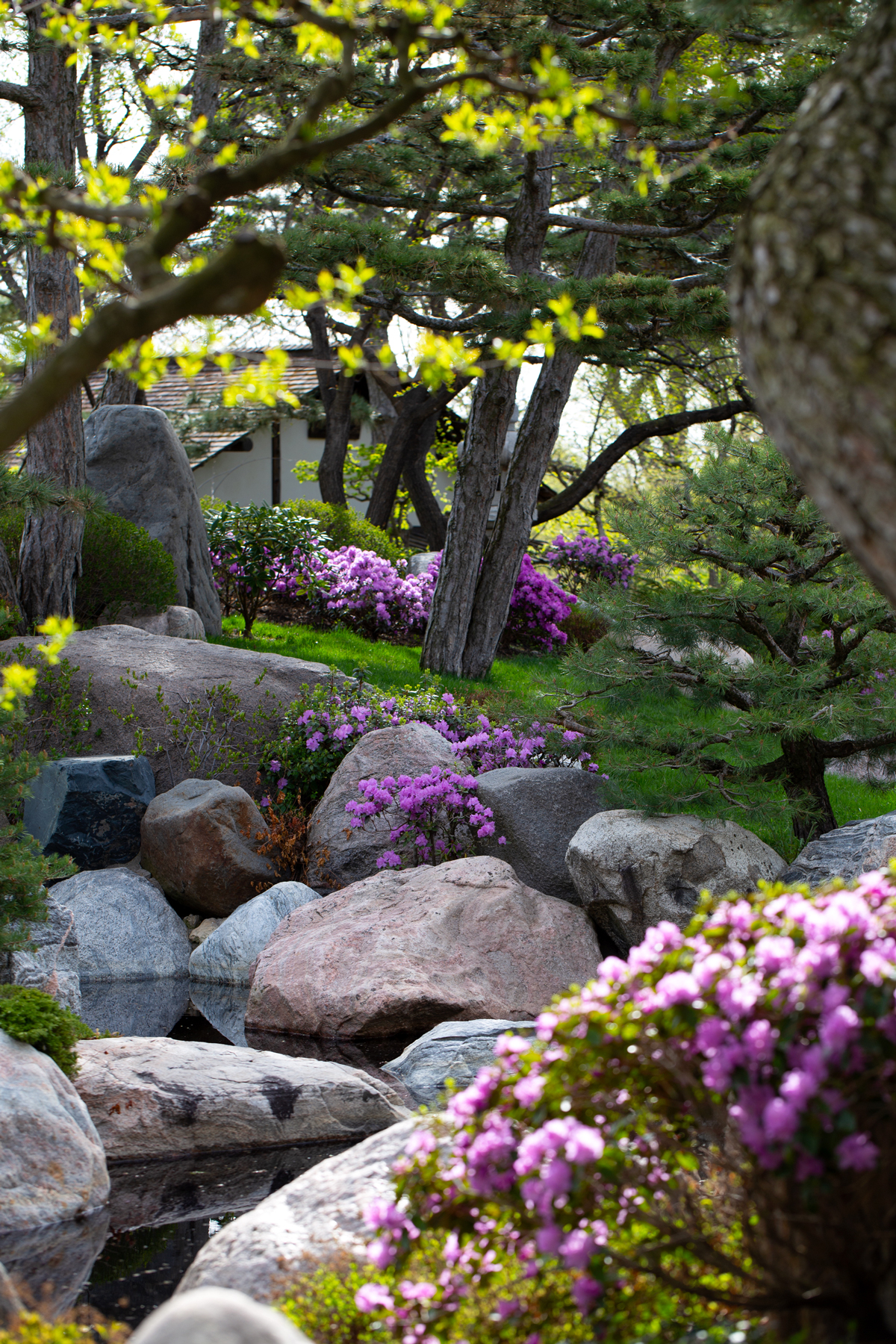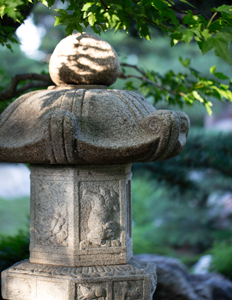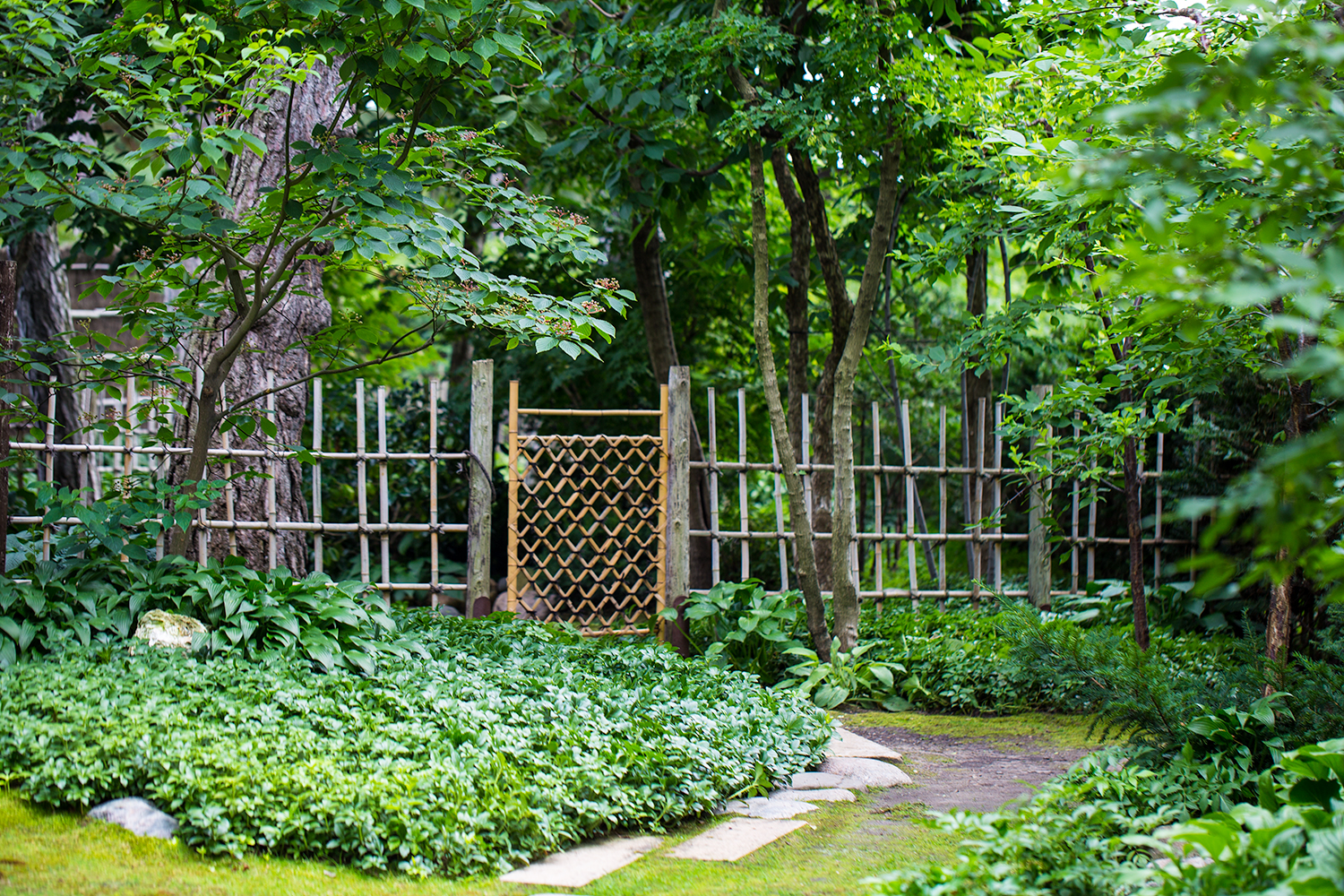Como’s redesigned Residency Program is bringing the power of plants and animals to third graders across the state

Residency Program students from Roseville’s Central Park Elementary School recently welcomed two new African crested porcupines to Como Zoo’s Large Cat Building by making artwork for their habitat. The porcupine pair were recently relocated to Como following the closure of SeaQuest in Roseville.
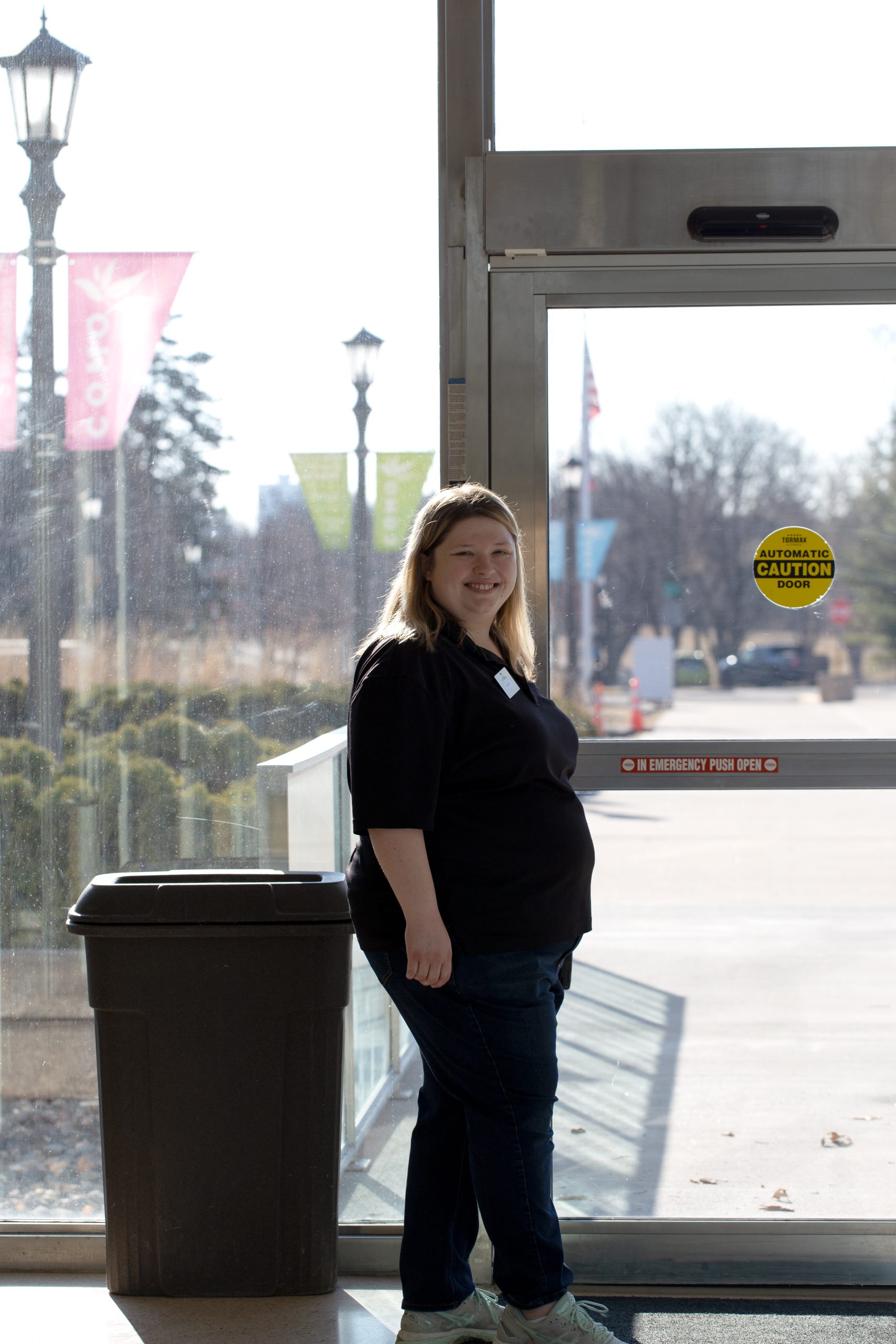

Melrose, Minnesota, is more than a 90-minute drive to Como Park Zoo and Conservatory—longer during rush hour—which makes a field trip to the Twin Cities out of the question for most classrooms.
But thanks to Como’s new and improved Residency Program, 25 third graders in Ms. Brown’s class at Melrose Area Elementary School recently got the chance to spend quality time with Katie Raeker, an educational specialist who knows nearly everything there is to know about Como’s plants and animals. During the course of four days in April, Raeker visited the class for nearly five hours every day, bringing live plants, biofacts, fun animal profile videos and boxes and boxes of art supplies to teach a program called Exploring Ecosystems, that compares the biomes of Minnesota to those of the Brazilian rainforest.
“What’s really fun about teaching kids in greater Minnesota is that they often have first-hand experience with the animals I often bring up in class,” says Raeker. “If I show them a pair of antlers, they know the difference between a deer and a moose. And if I ask ‘How many of you have seen a wolf?’ lots and lots of hands go up. Compared to the kids we teach in the Twin Cities, it leads to very different conversations.”
Taking Como’s education curriculum on the road is the latest iteration of Como’s Residency Program, an immersive conservation program offered free of charge to area schools and made possible by Minnesota’s Legacy Amendment. Several years ago, this popular program got its start by inviting classrooms around the Twin Cities to relocate to Como, using both Como Zoo and the Marjorie McNeely Conservatory as the backdrop for days of cross-disciplinary learning. Put on pause during the pandemic, the Residency Program resumed in January 2025, simultaneously offering on-site experiences for third grade classrooms around the Twin Cities, and off-site programs for third graders across the state.
In fact, the same day Raeker was teaching in Melrose, Residency Program Specialist Grace Coughlin was leading a group of third graders from Roseville’s Central Park Elementary into a new habitat in the Large Cat Building that is now home to two new porcupines. Large cat keepers Hans Jorgensen and Caitlin Allessi greeted the group, and invited them to decorate the glass enclosure with big rolls of craft paper and magic markers.
“So many of the teachers have been telling us how grateful they are for the opportunity to have an art component to the program,” says Residency Coordinator Madeline McCullough. “The other thing we’re hearing is that they really appreciate our multi-modal approach with our curriculum. There’s movement throughout the day, videos and slideshows and pictures, class discussions, and very tactile experiences with biofacts and plants. The curriculum makes them feel supported, and it works to reach many different types of learners.” Another strength of the program: McCullough, Coughlin, and Raeker are all former classroom teachers, skilled at shaping lesson plans to fit the needs of participating classrooms.
With a waiting list of schools eager to sign up, Como has prioritized Title I classrooms where a significant portion of students are from disadvantaged backgrounds, or are eligible for free or reduced-price lunch. In addition to the free classroom experience, Como reimburses local schools for the full cost of bus transportation to campus, ensuring that cost is no barrier to participation. While nearly half of the programs happen right on Como’s campus, for many participating students, it’s their very first trip to Como Park Zoo and Conservatory. “Even though Como is in the backyard for a lot of our participating schools, a lot of kiddos have never been to a zoo before,” says Coughlin. “It’s really fun to show them around and to see their faces the first time they see a giraffe, or watch a sea lion swimming in the water.”
The focus on third graders helps area schools meet state science standards, while connecting with kids in the sweet spot for conservation education. “It’s the perfect age for this program, because they’ve been in school enough years that they have the basic skills down, and they’re a little bit more independent so they can be critical thinkers and sponges for information,” says Raeker.
“Also third graders have no filter, and they have so many interesting questions,” says Coughlin. “Kids are always excited to find out that Como is free and open every day. And a lot of them really want to know when they can come back with their parents.”

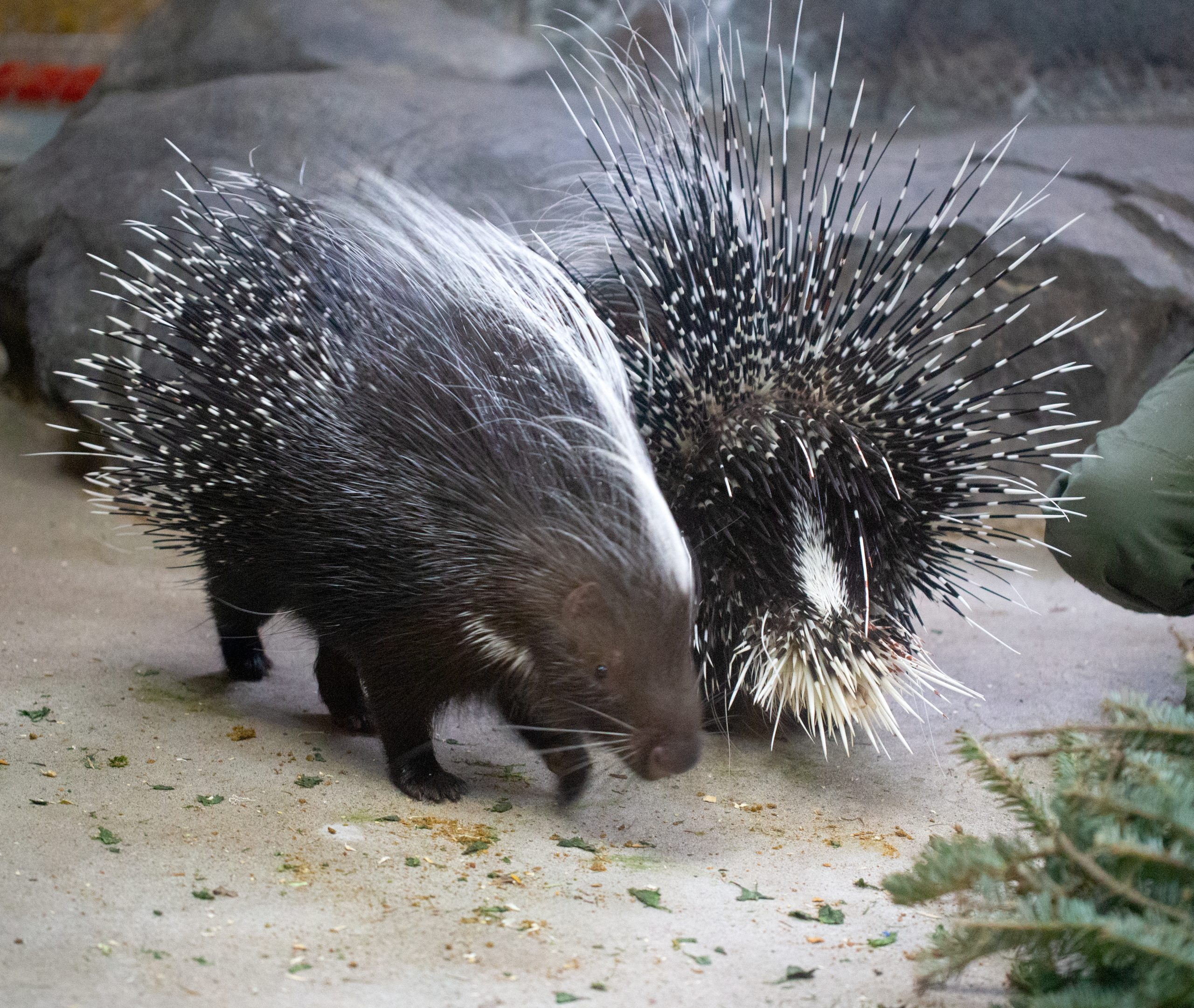
Como’s education programs are back in full force, with a growing emphasis on discoveries that foster new connections with nature.
“What do you think this plant would taste like?” a second grader from St. Paul’s Capitol Hill Magnet School wonders aloud.
“Yucky,” says her classmate, as she contemplates a table full of mint, cacao and other plant specimens from the Marjorie McNeely Conservatory.
“But maybe not,” says a third student, leaning in for a sniff. “This one kind of smells nice…”
Using all five senses to explore the world of plants is the power of Plant Detectives, a popular school partnership that brings second graders from the St. Paul public schools to Como with free tuition provided by Como Friends. In a classroom in Como’s Visitor Center, small teams of students work their way from station to station, smelling, touching and observing all they can about plants, and comparing their notes in a high-energy setting guided by Como’s education specialists.
During the pandemic, when school programs like this were put on pause, virtual programs like Como Connections helped classrooms around the state learn about conservation through fun and interactive videos. But as education coordinator Tim Buer says, there’s nothing like being back in person again for getting kids fired up about learning. “It’s been great to re-establish the connection that we’ve had with schools for so many years,” he says. “We don’t even have any space left in this program, it’s been so popular with teachers.”
Como field trips are a familiar tradition for many schools, but this year, the conservation curriculum is taking a new shape thanks to a new education strategic plan supported by Como Friends.
“As our school partners were coming out of COVID, we took the opportunity to think really intentionally about all of our education programs, making sure that they’re all aligned with our conservation mission,” says Bekah Hanes, Como’s education and conservation curator.
Through Como’s growing partnership with Advancing Conservation Through Empathy (ACE) for Wildlife, a nationwide learning network, Como’s education programs have also been updated to reflect the growing body of research that shows that fostering empathy with animals and plants is a powerful tool in building life-long conservation behaviors.
Como visitors will notice the new conservation-focused vibe all across campus, from the full roster of summer camp programs relaunching this summer, to the new field trip enrichment stations you’ll see near the Visitor Center during the busy spring months. “It’s wonderful to hear the noise and energy of kids being in classroom spaces that we haven’t used for awhile,” says Hanes. “Seeing those school buses come back, and knowing the next field trip is on its way here brings us all a lot of joy.”
BACK TO CLASS WITH COMO FRIENDS
Your support for Como Friends has been critical to the resurgence of Como’s education programs this year, with new scholarship offerings for schools and families. Here’s a look:
Hitching a ride: With rates for school bus rentals on the rise, Como Friends is helping provide bus scholarships to schools in need to ensure that finances are never a barrier to school field trips.
Summer camp surge: After a successful pilot run last season, Como’s popular summer camps are making a full return with 12 weeks of great programs about animals and plants for preschoolers through sixth graders. Como Friends provided scholarship funding for families to enroll in Camp Como this season. Your Como Friends’ membership can also help save 10 percent off your registration costs.
St. Paul Partners: With field trips back in full swing, Como has resumed its popular second grade field trip program with the St. Paul public schools, a program paid for by Como Friends.
Nature Walk: Led by teens taught to interpret Como’s animal and plant collections, this engaging conservation program is all about getting the next generation excited about nature. At interpretive carts stationed around Como during the busy summer months, Nature Walk volunteers role-model what’s cool about conservation, connecting with an estimated 200,000 visitors every year.
Curriculum Updates: With a new focus on fostering empathy with animals and plants, Como’s education department hired a dedicated curriculum writer to update all of Como’s programs with best practice strategies for inspiring the next generation of environmental stewards.
Personalizing nature is one of the first steps in protecting it
Sparky, Neil, Chloe, and Schroeder are just a few of the Como Park Zoo & Conservatory animals known to millions of visitors by their first names. Though there was once a time when zoos shied away from showcasing the individual animals in their care, a growing body of research now tells us that encouraging the public to forge personal connections to nature is one of the best ways to protect it.
That thinking is the driving force behind a series of new education and engagement strategies now in effect at Como Park Zoo & Conservatory, thanks to support from Advancing Conservation through Empathy (ACE) for Wildlife, a learning network of AZA-accredited zoos, aquariums, and other institutions exploring effective practices for fostering empathy for animals.
“The old theory was that simply sharing knowledge would be enough to inspire action, but what we’re coming to realize is that fostering meaningful emotional connections is just as important. Having empathy for an animal builds the desire to act on their behalf,” says Bekah Hanes, Como’s education and conservation curator. “Empathy is a skill you can develop and build on, and it’s becoming an important tool to help people cross the finish line from thinking about conservation to actually acting out those values, long after a zoo visit is over.”

The official shift toward empathy-focused engagement started in 2016, when Como Friends secured a major grant to help Como Park Zoo & Conservatory implement a new education and engagement strategy called the ROADMAP (Reaching Our Audiences by Developing Mission Aligned Programs). While the pandemic put a pause on public education programs for a time, Como continued to move ahead with its mission, securing grants from ACE for Wildlife to rewrite Como’s volunteer interpretive programs with an empathy focus, to use empathy as the lens for a new education strategic plan, and to create new permanent signage in the wolves and large cats habitat that uses empathy-inspiring language. While Como is one of the inaugural members of the ACE for Wildlife Learning Network, a special project of Seattle’s Woodland Park Zoo, the empathy movement is gaining ground with many other AZA-accredited zoos and aquariums.

Public Engagement Coordinator Kelsey Raffel says “it’s a great shift that’s happened in a relatively short amount of time,” in part because it embodies an approach toward audience engagement that Como’s keepers, horticulturists, interpreters, and educators gravitate toward naturally. “Focusing on empathy in our education programs, volunteer training, and visitor engagement has gotten a great reception from the campus,” she says. “For instance, our interpretive staff have shared that they love talking about the individual animals we care for, their personalities and likes and dislikes, and this approach really encourages them to do that.”
Jackie Sticha, president of Como Friends, says community support is critical to providing the resources Como Park Zoo & Conservatory needs to stay current as a conservation educator and a national leader in animal care. “More than 20 years ago, Como Friends funding helped Como Zoo make a shift toward positive reinforcement training for animals, and we see this empathy work as part of that same evolution,” she says. “It’s just natural to want to know the names of the animals at Como Zoo, and now the research tells us it’s also a really powerful way of connecting visitors to the natural world.”
Parking will Remain Free at Como Park Zoo & Conservatory!
Como Friends is happy to share that the City of Saint Paul has determined that parking will remain free in Como Regional Park, including at Como Park Zoo & Conservatory and will not be pursued for the 2021 budget.
The decision was made based on findings from the Paid Parking Feasibility Study. Key discoveries included a likely decline in people visiting Como Park Zoo & Conservatory because of paid parking and a decline in food and retail purchases during a visit.
Como Friends will advance our mission-driven work to inspire support for the zoo and conservatory so it remains a vibrant and welcoming place where future generations can explore and make memories.
Be sure to join our Como Promo email newsletter list at https://comofriends.org/get-involved/the-como-promo/ to stay informed on the latest developments, and to learn more about Como Friends’ advocacy work on behalf of the nearly two million visitors who come to Como Park Zoo & Conservatory every year. Thank you for all you do to support free access and needed improvements at Como Park Zoo & Conservatory, to ensure this beloved treasure is thriving for generations to come.
Parking will Remain Free at Como Park Zoo & Conservatory!
Como Friends is happy to share that the City of Saint Paul has determined that parking will remain free in Como Regional Park, including at Como Park Zoo & Conservatory and will not be pursued for the 2021 budget.
The decision was made based on findings from the Paid Parking Feasibility Study. Key discoveries included a likely decline in people visiting Como Park Zoo & Conservatory because of paid parking and a decline in food and retail purchases during a visit.
Como Friends will advance our mission-driven work to inspire support for the zoo and conservatory so it remains a vibrant and welcoming place where future generations can explore and make memories.
Be sure to join our Como Promo email newsletter list at https://comofriends.org/get-involved/the-como-promo/ to stay informed on the latest developments, and to learn more about Como Friends’ advocacy work on behalf of the nearly two million visitors who come to Como Park Zoo & Conservatory every year. Thank you for all you do to support free access and needed improvements at Como Park Zoo & Conservatory, to ensure this beloved treasure is thriving for generations to come.
DID YOU KNOW?
- Como Friends’ support has been essential to the growth of the Marjorie McNeely Conservatory’s Japanese horticultural collection, providing 100 percent of the funding for The Ordway Gardens wing opened in 2013.
- Louis W. Hill, Jr., grandson of railroad executive James J. Hill, is credited with starting St. Paul’s “town affiliation” with Nagasaki. A fan of Asian art, Hill had been to Nagasaki before World War II.
- The Obon Festival, the high-point of the Japanese garden’s summer season, is on August 21, 2022.
Parking will Remain Free at Como Park Zoo & Conservatory!
Como Friends is happy to share that the City of Saint Paul has determined that parking will remain free in Como Regional Park, including at Como Park Zoo & Conservatory and will not be pursued for the 2021 budget.
The decision was made based on findings from the Paid Parking Feasibility Study. Key discoveries included a likely decline in people visiting Como Park Zoo & Conservatory because of paid parking and a decline in food and retail purchases during a visit.
Como Friends will advance our mission-driven work to inspire support for the zoo and conservatory so it remains a vibrant and welcoming place where future generations can explore and make memories.
Be sure to join our Como Promo email newsletter list at https://comofriends.org/get-involved/the-como-promo/ to stay informed on the latest developments, and to learn more about Como Friends’ advocacy work on behalf of the nearly two million visitors who come to Como Park Zoo & Conservatory every year. Thank you for all you do to support free access and needed improvements at Como Park Zoo & Conservatory, to ensure this beloved treasure is thriving for generations to come.
DID YOU KNOW?
- Como Friends’ support has been essential to the growth of the Marjorie McNeely Conservatory’s Japanese horticultural collection, providing 100 percent of the funding for The Ordway Gardens wing opened in 2013.
- Louis W. Hill, Jr., grandson of railroad executive James J. Hill, is credited with starting St. Paul’s “town affiliation” with Nagasaki. A fan of Asian art, Hill had been to Nagasaki before World War II.
- The Obon Festival, the high-point of the Japanese garden’s summer season, is on August 21, 2022.
While the historic Como Zoo and the Marjorie McNeely Conservatory are two of St. Paul’s most beloved cultural treasures, only 16 percent of Como’s average 1.7 million annual visitors come from the Capital City. “An even larger number of visitors, more than 400,000 every year, are actually from greater Minnesota, and 15 percent come from outside the state,” says Michelle Furrer, Como’s Campus Director. “The sheer number of visitors to Como makes clear that we’re an important part of the tourism economy.” In fact, a 2015 study from Sapphire Consulting found that Como annually generates more than $162.7 million in economic impact for our region, along with nearly 2,100 jobs.
Just as important to Minnesota lawmakers, says Furrer, was the strong public/private partnership between Como Friends and Como Park Zoo and Conservatory. “Seeking state funding is a competitive process because there are so many needs across the state,” she says. “Having a strong track record of success working with Como Friends to build improvements like Polar Bear Odyssey and The Ordway Gardens definitely strengthened our case. It showed legislators that we had the community support behind us to leverage additional dollars to achieve our goals with Como Harbor.”
“We’re so proud of what our supporters have made possible in Como Harbor,” says Jackie Sticha. “Generous philanthropic gifts and public funding mean that transformational improvements are possible at Como without compromising our commitment to free admission and barrier-free access for everyone.”
One of Como Zoo’s first female keepers, Marisa Paulat has spent 43 years loving and learning from large cats
Zookeeping was a male-dominated profession in the late 1960s when 11-year-old Marisa Paulat announced to her parents that she wanted to take care of the animals at Como Zoo. A decade later, when she was finally old enough to apply for a position, there were still just two women on Como Zoo’s staff, “and they made it clear they didn’t want to hire any more,” Paulat says, remembering the demanding physical endurance test she was required to pass in 1979 before she could be considered for the job.
“The idea was to weed out any women who were going to apply. But I practiced all summer running 50 yard dashes with a 50 pound sandbag on my shoulder,” she says. “I was not going to let them take this chance away from me.”
That tenacity helped earn Paulat her dream job caring for Como Zoo’s large cats, where she’s enjoyed a reputation for winning over felines too big to be toyed with. “If there’s one thing I’m good at, it’s breaking through to challenging animals that have maybe had some bad experiences in their lives,” she says. “Sometimes it takes months of perseverance, but if you leave me alone with them, I will break through.” Set to retire in late June after 43 years of service, Paulat recently sat down with Como Friends to share her secrets for making the world’s largest felines fall in love with her.
Zookeeping as a profession has really evolved over the last 40 years. What was it like when you started?
What surprised me when I first started was that it was more of a civil service job than it was about animal care, and there weren’t a whole lot of us on staff. So zookeepers were the jack-of-all-trades—we did the maintenance, we cleaned the buildings, we closed the gates, we did security, we made the public announcements, we answered the phone, we did the secretarial work, we got everyone off the zoo grounds at the end of the day. We counted the money from the pop machines and we weighed the big anaconda. If there was anything to do, we did it.
Your tenure also coincides with Como’s transition from being a small city zoo, to becoming an accredited zoo with a strong reputation for animal care.
Yes, one of the highlights of my career was being here from the very beginning and watching Como evolve the way it has. Como Zoo was supposed to close when they built the Minnesota Zoo—that was the game plan. But the neighborhood didn’t want that to happen, and instead, helped us to improve. I was part of the very first accreditation process with the Association of Zoos and Aquariums which was really hard work, and we’ve been continually reaccredited ever since. Enrichment is, in my eyes, the most important thing we can do for animals, and that began to grow at the same time new buildings were going up. The building that enabled the Zoo to move forward the most was the new Visitor Center in 2003—that’s when things just skyrocketed forward with higher-end functions like classrooms, and rental space for weddings, and a beautiful building for the community. Being able to reach out to the public like that helped us to move forward faster.
Teaching the public about what zoos can do to support conservation has also moved front and center at Como.
That’s really true. One of the things I’m very proud of is what we’ve done for cougars. In the old days, we had cougars that had come from people’s homes as pets, which is not something we want to encourage. When one of our cougars died of old age, I talked our zoo director into keeping the exhibit empty for a couple of years until we could rescue orphaned cougars from the wild. In the 1980s, U.S. Fish and Wildlife preferred to euthanize cougars that were orphaned in the wild, so I worked with another keeper in Oregon to convince them that cougar cubs from the wild would have good homes in zoos. Sienna and Sierra were the first two cubs we helped save from the wild, and now, of course, we have Ruby and Jasper. Every zoo in the nation now gets their cougars from the wild, and we don’t breed them because there are so many orphaned cubs that need rescuing. I’m very proud of what we did to convince them that zoos could be part of the solution.
During your career, you must have given thousands of keeper talks about large cats. Of the 40 known species of wild cats in the world, which kind are your favorite?
The striped and spotted ones, tigers and leopards, are the most beautiful of the cats. But after caring for so many African lions here at Como, I think they’re my favorite. They’re the only species that live in groups called prides, and watching the social interactions between the males and females, the whole family structure, and how the males actually help with cubs, I just find them the most fascinating.
You became an honorary member of the pride by raising one of Como Zoo’s most legendary lions, Mufasa, by hand from the time he was just three weeks old. How did that happen, and what kind of relationship did the two of you have?
His mother, Wynona, was a great mother to previous litters and other cubs who came after him. But she had a birth canal infection not long after he was born, and pushed him away and stopped feeding him. So it was my job to bathe him, and burp him and bottle-feed him until he could be reintroduced to his sister Savanna at about six months old and learn how to be a lion. When he was just a year old, he broke his leg while he was on exhibit, and I was able to talk him in on three legs to come into the building, because he trusted me. Every morning for 17 years when I walked in, he would vocalize and push his head against the mesh. I had the privilege of seeing the entire life of an animal, from beginning to end, in a way that most zookeepers will never get a chance to see. I was “Mom” to Mufasa until the day he died.
Very few humans will ever get to know a magnificent animal like Mufasa in quite the way you did. What are the secrets to building that connection with large cats, or with any other animal?
There’s only one secret—to love them so much. If you care about them so much, they know and they’re going to respond to that. And then every day after that, every action you take will be based on how much you care, and it’s going to be the right thing. You can’t go wrong then, because you’re working from your heart.
Have you ever had any close calls?
No. Never. That’s my story and I’m sticking to it.
So a prowling tiger or a roaring lion doesn’t intimidate you?
You should be intimidated! If you don’t jump, that makes them feel so bad. But you do get to the point where you expect it and you don’t jump as much. Though every once in a while they’ll try to catch you off-guard.
Any parting advice for your fellow zookeepers?
Yes! I always tell people to squeeze the clicker and not the reinforcement. Never park under the snow leopard habitat unless you want your car to have a very special snow leopard smell after you leave, besides that, my parking spot! Don’t ever move the spoon—my cat keeping colleague Hans will know what that means. Don’t Google “wild cougars in Minnesota”—you have no idea what will come up! Look out for Nicholas, the tiger ghost. Cats aren’t the only ones who like benches. And, find enjoyment every day you have here at Como—it’s a special place.
